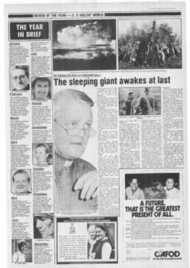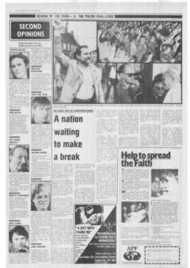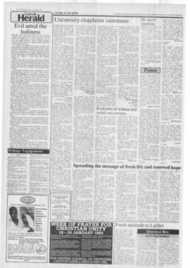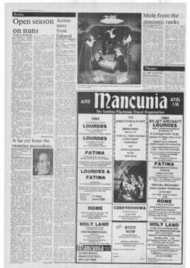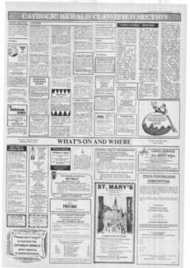Page 3, 23rd December 1983
Page 3
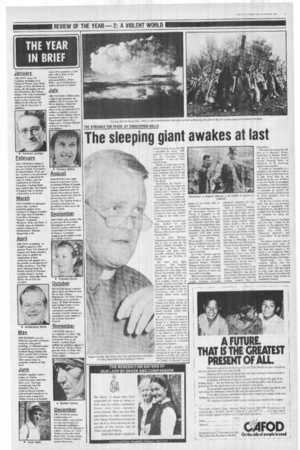
Report an error
Noticed an error on this page?If you've noticed an error in this article please click here to report it.
Tags
Share
Related articles
He Sleeping Giant Stirs
Ecumenism: Need For
Government's Failure To Use Bishops' Peace Points Deplored .
The Bomb
Bruce Kent Tilts At Sleeping Giant
Slogans About Peace By World Leaders 'not Enough' Says Pope
The sleeping giant awakes at last
IN MY PEACE review for 1982 I concluded by saying "1983
could be a very interesting year for the Christian peace movement." I have not been proved wrong.
Thanks in many ways to the peace movement, the issue of nuclear weapons has become the most dominant topic in current affairs. Not unnaturally, the Churches have played their part in thc debate.
Significantly the Church — referred to little more than two years ago by Mgr Kent as "the sleeping giant", because of its apparent apathy towards the nuclear debate — has woken up.
Christian CND now forms the largest single group within CND as a whole (about 25 per cent of CND's membership); laypeople, bishops and priests have all been involved in some way, whether in debate or non-violent direct action.
Church leaders' attitudes have betIn looked at with apprehension and anxiety by most Western governments. Bishops, after all, are significant opinion leaders.
In the event, Western European governments have had little to fear, at least on the surface. Catholic hierarchies in England and Wales, France, Germany and Italy have generally endorsed deterrence and cruise and Pershing 11 missiles.
But there have been exceptions. The Scottish Catholic hierarchy have shown themselves far from happy with British Government policy and have called on Christians to support the peace movement. More recently, leaders of all Scottish churches including the entire Catholic episcopate, have protested to the Queen that the Government has tried to smother debate about cruise missiles.
Even the Catholic bishops of England and Wales, though far more guarded in public than their Scottish counterparts, have almost certainly shifted their ground in the past year.
In January Archbishop Worlock of Liverpool spoke in favour of a unilateral gesture aimed at scaling down nuclear stockpiles. After the bishops' November meeting Robert Low of the Observer, reported that more than a dozen of the 42 bishops appeared to be moving
This could certainly be worrying to a government determined to show that public opinion is on their side. But of more historical significance was the Church of England Synod debate on the bomb, held on February 10.
It was of crucial importance to the Government because the Church of England, as the established Church, is part of the British constitution. There must therefore have been sighs of relief in Downing Street when the Bishop of Salisbury's amendment, that Britain should dissociate itself from nuclear weaponry,was heavily defeated.
But the Bishop of Birmingham's proposal that Britain should forswear any first use of nuclear weapons was carried — a bizarre twist to a contorted debate.
Yet if Mrs Thatcher and her colleagues were not unhappy about result of the Church of England/ debate, President Reagan must have been sweating over the United States' Catholic bishops' pastoral on peace and war, published in May.
The pastoral demanded a halt to nuclear arms production and sought bilateral verifiable agreements between the two superpowers to this end.
Back in Britain, Catholics have been conspicuous among those who have taken part in non-violent direct action against nuclear weapons. The recentlyformed group Catholic Peace Action caused a stir in April when four of its members, including a Catholic priest, poured ashes and phials of their own blood over the entrance to the Ministry of Defence buildings in Whitehall, in true Old Testament-style disapproval of the evil of nuclear weapons.
They were arrested and appeared at Bow Street Magistrates Court, but were conditionally discharged — evidence of the Government's determination not to have a showdown with the Church.
At Pentecost, the prior of the Dominican friary in Oxford, Fr Timothy Radcliffe, was one of 35 Christian CND members who illegally entered Upper Heyford nuclear bomber base in Oxfordshire.
They were not arrested but the dean of St Edmund's House, Cambridge, Fr Michael Winter, was one of 70 people arrested outside Downing Street on November 16 for protesting against cruise missiles.
It would be impossible in a roundup of this length to look in depth at the treatment meted out to Mgr Bruce Kent by the media during the year. Suffice it to say that thanks to newspapers sympathetic to the Government, Mgr Kent has twice been used as a scapegoat to provide the Government with a smokescreen to divert attention from its nuclear policies.
On the first occasion, in late April, Mgr Kent was portrayed as being at loggerheads with Cardinal Hume, and likely to be recalled from his CND post by the Cardinal for being too political.
The debate raged in the media well into May, fuelled by the remarks of the Apostolic ProNuncio, Archbishop Bruno Heim, that CND were "blinkered idealists" and "useful idiots" in the Russian cause.
The second occasion came in November, when most of the press erupted in fury because Mgr Kent had spoken a few words at the Communist Party conference, thanking them for supporting the peace movement.
Significantly, the first occasion tallied with the announcement of a general election, when CND had aimed to make cruise the real voting issue. The second coincided with the arrival of cruise missiles at Greenham Common.
blog comments powered by Disqus




